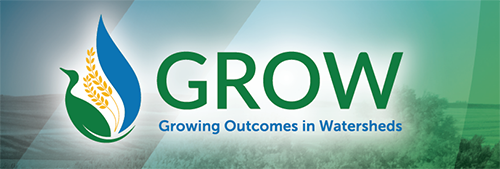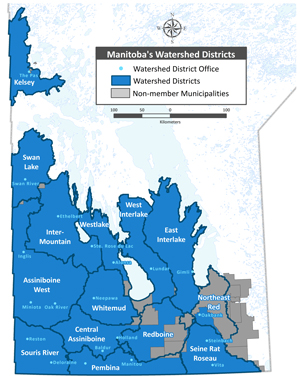
Growing Outcomes in Watersheds (GROW)
- GROW Cover Crop - East Interlake Watershed District
- GROW Riparian Buffer - Seine Rat Roseau Watershed District
- GROW Upland Restoration - Redboine Watershed District
- GROW Wetland Enhancement - Central Assiniboine Watershed District
What is GROW?
GRowing Outcomes in Watersheds (GROW) is a new, made-in-Manitoba approach to encourage and support the delivery of ecological goods and services (EG&S) in Manitoba. Identified under the Water Pillar in Manitoba’s Climate and Green Plan, GROW focuses on watershed health, management and resiliency.
Two priority outcomes for GROW are improved watershed resilience to the impacts of a changing climate (i.e., reduced flooding and drought vulnerability) and improved water quality (i.e., sediment and nutrient management). Co-benefits include improved on-farm water management, enhanced sustainable agricultural production, improved biodiversity and habitat, and carbon sequestration and storage.
Who delivers GROW?
GROW is delivered by Manitoba’s Watershed Districts through Local GROW Committees. Watershed Districts are ideally positioned to support actions identified in their watershed management plans that meet local and provincial priorities.
Watershed Districts can obtain funding to deliver GROW through a number of different sources. The Conservation, GROW and Wetlands GROW Trusts can provide both project establishment and incentive payment costs. Additional funding programs also support the establishment and delivery of EG&S programming, including Manitoba’s Watershed Districts Program, Ag Action Manitoba – Assurance: Watershed Ecological Goods and Services through Manitoba Agriculture, as well as other provincial, federal, municipal and local funding sources where priorities align with GROW.
For more information on Local GROW Programs delivered in your area, please contact your local watershed district.
What activities are eligible under GROW?
In order to achieve targeted improvements to watershed health, Local GROW Committees (watershed districts) focus on priority outcomes and co-benefits that are consistent with integrated watershed management plans. Activities that are eligible for inclusion in a Local GROW Program include:
- water retention
- wetland conservation, restoration or enhancement
- riparian area conservation, restoration or enhancement
- buffer establishment (ex: shelterbelts and multi-species buffer strips)
- upland area conservation, restoration, or enhancement (ex: woodlot management, grassland conservation, converting marginal cropland to grassland, and soil health improvements)
- innovative approaches - other projects
Please contact your local watershed district to see what activities are available in your watershed.
How is GROW different?
There are two types of landowner incentives:
1. Establishment costs: This is the cost of establishing projects that provide enhanced or new EG&S. These costs include labour, equipment and material costs, and eligibility is at the discretion of the watershed district or Local GROW Committee. Landowner cost-shares may vary, depending on watershed district, local priorities, project type and local conditions.
2.Annual payments (not required for all projects): Annual incentive payments for acres enrolled in GROW are available for producers. Watershed districts or Local GROW Committees set annual payment rates for participating landowners (where required).
How do I find out what types of GROW projects are offered in my area?
For more information on Local GROW Programs delivered in your area, please contact your local watershed district.
What if my municipality is not part of a watershed district?
The Watershed District Program is a voluntary municipal partnership program aimed at improving watershed health in Manitoba. Talk to your local municipality about opportunities to join the Watershed Districts Program.



